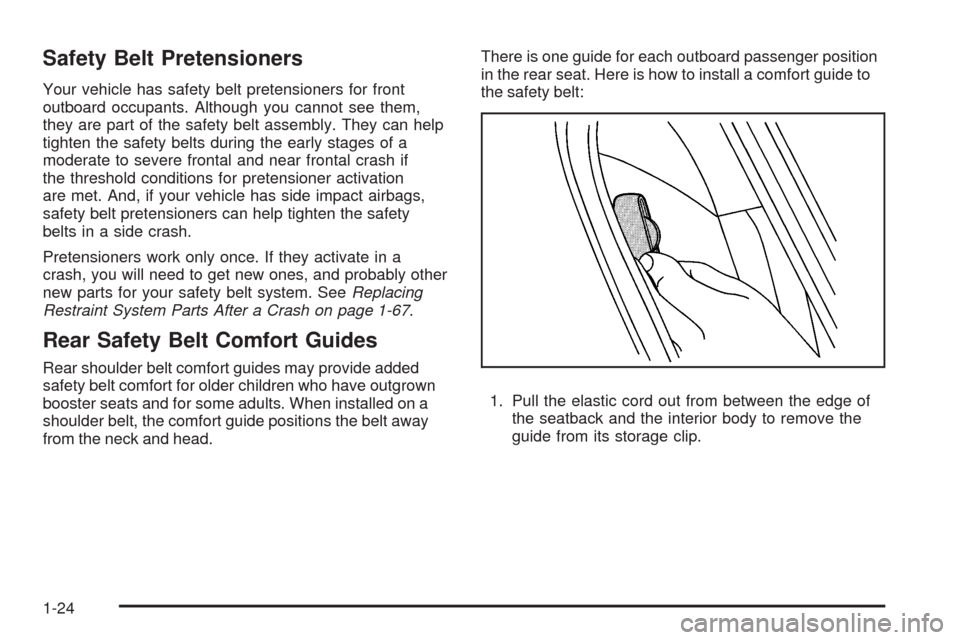Page 28 of 514

Safety Belt Pretensioners
Your vehicle has safety belt pretensioners for front
outboard occupants. Although you cannot see them,
they are part of the safety belt assembly. They can help
tighten the safety belts during the early stages of a
moderate to severe frontal and near frontal crash if
the threshold conditions for pretensioner activation
are met. And, if your vehicle has side impact airbags,
safety belt pretensioners can help tighten the safety
belts in a side crash.
Pretensioners work only once. If they activate in a
crash, you will need to get new ones, and probably other
new parts for your safety belt system. SeeReplacing
Restraint System Parts After a Crash on page 1-67.
Rear Safety Belt Comfort Guides
Rear shoulder belt comfort guides may provide added
safety belt comfort for older children who have outgrown
booster seats and for some adults. When installed on a
shoulder belt, the comfort guide positions the belt away
from the neck and head.There is one guide for each outboard passenger position
in the rear seat. Here is how to install a comfort guide to
the safety belt:
1. Pull the elastic cord out from between the edge of
the seatback and the interior body to remove the
guide from its storage clip.
1-24
Page 80 of 514

6. Place the new transmitter into the transmitter
pocket, located inside the center console storage
area located between the driver and front passenger
seats, with the transmitter buttons facing the front
of the vehicle.
7. A beep sounds once programming in complete.
The DIC displays READY FOR 3 or 4, or
MAX # FOBS LEARNED.8. Remove the transmitter from the transmitter pocket
and press
Ktwice on each newly programmed
transmitter to complete the process.
9. To program additional transmitters, repeat Step 6.
Press Acc. on the ignition switch if programming is
complete.
Programming without a Recognized
Transmitter
This procedure requires three ten minutes cycles to
complete the programming process. United States
owners are permitted to program a new transmitter
to their vehicle when a recognized transmitter is not
available. The Canadian immobilizer standard requires
that Canadian owners see their dealer/retailer for
programming new transmitters when two recognized
transmitters are not available.
1. The vehicle must be off.
2-8
Page 81 of 514

2. Place the new transmitter into the transmitter
pocket, located inside the center console storage
area located between the driver and front passenger
seats, with the transmitter buttons facing the front
of the vehicle.
3. Insert the vehicle key into the key lock cylinder
located on the driver door.
4. Turn the key to the unlock position �ve times within
�ve seconds.5. The DIC message displays OFF/ACC TO LEARN.
6. Press Acc. on the ignition switch.
7. The DIC reads WAIT 10 MINUTES and counts
down to zero.
8. The DIC displays OFF/ACC TO LEARN again.
9. Press Acc. on the ignition switch.
10. Steps 7, 8 and 9 will be repeated two more times.
11. A beep sounds and the DIC reads READY
FOR FOB 1. All previously known transmitter
programming has been erased.
12. A beep sounds once programming in complete.
The DIC displays READY FOR FOB #2.
13. To program additional transmitters, take
transmitter 1 out of the transmitter pocket and
place transmitter 2 in the pocket. Up to four
transmitters can be programmed. The DIC will
then display MAX # FOBS LEARNED and will
exit the programming mode.
14. Remove the transmitter from the transmitter pocket
and press
Ktwice on each newly programmed
transmitter to complete the process.
2-9
Page 205 of 514

Rear Window Defogger
The rear window defogger uses a warming grid to
remove fog or frost from the rear window.
The defogger only works when the ignition is on or
during remote start, if programmed. See “Personal
Settings Menu” underVehicle Personalization on
page 2-61for additional information.
=(Rear Window Defogger):Press to turn the rear
window defogger on or off. The rear window defogger
stays on for 10 minutes, before turning off.
If the vehicle’s speed is above 30 mph (48 km/h), the
rear defogger stays on continuously. If turned on again,
the defogger only runs for about �ve minutes before
turning off. The defogger can also be turned off by
turning off the engine.The heated outside rearview mirrors also heat to help
clear fog or frost from the surface of the mirror when
the rear window defogger is on. SeeOutside Heated
Mirrors on page 2-41.
Notice:Do not use a razor blade or sharp object to
clear the inside rear window. Do not adhere anything
to the defogger grid lines in the rear glass. These
actions may damage the rear defogger. Repairs
would not be covered by your warranty.
{(Ventilated Seat):If the vehicle has this feature,
press to turn the driver or passenger side ventilated seat
on. SeeHeated and Ventilated Seats on page 1-3.
J(Heated Seat):If the vehicle has this feature, press
to turn the driver or passenger side heated seat and
seatback on. SeeHeated and Ventilated Seats on
page 1-3.
3-51
Page 454 of 514
Rear Underseat Fuse Block
Removing the Rear Seat Cushion
Notice:If you touch the exposed wires with the
metal on the seat cushion, you could cause a
short that could damage the battery and or wires.
Avoid contact between the rear seat and the
fuse center whenever you remove or reinstall
the rear seat. Do not remove covers from any
of the covered parts, and do not store anything
under the seats.
To remove the rear seat cushion, do the following:
1. Pull up on the front of the cushion to release the
front hooks.
2. Pull the cushion up and out toward the front of the
vehicle.To reinstall the rear seat cushion, do the following:
5-128